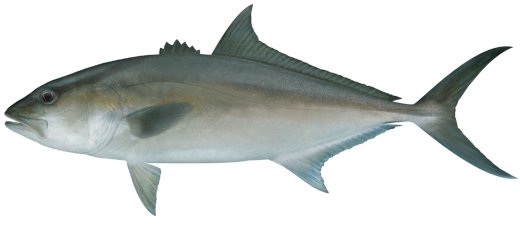PompanoDescription: greenish gray on back, shading to silvery sides; fish in dark waters showing gold on throat, pelvic, and anal fins; deep flattened body with small mouth; no scutes; 22 to 27 soft dorsal rays; 20 to 23 soft anal rays; origin of anal fin slightly behind origin of second dorsal. Where found: INSHORE and NEARSHORE waters, especially along sandy beaches, along oyster banks, and over grassbeds, often in turbid water; may be found in water as deep as 130 feet. Size: usually less than 3 pounds. Florida Record: 8 lbs, 1 oz. Remarks: spawns OFFSHORE between March and September; feeds on mollusks and crustaceans, especially sand fleas; local movements are influenced by the tide, and seasonal movements are influenced by temperature. How to catch: from the beach, over the sandy bottom Flies to use: small crustacean patters, clousers and shrimp patterns. Black Drum
Description: high arched back; 10 to 14 pairs of chin barbels; gray or black colored body in adults; young have 4 to 6 vertical bars; has cobblestone-like teeth capable of crushing oysters; scales large. Where found: INSHORE fish common to bays and lagoons; bottom dweller often found around oyster beds; also OFFSHORE. Size: common to 30 pounds. Florida Record: 93 lbs. Remarks: largest member of the drum family; spawns NEARSHORE in winter and early spring; feeds on oysters, mussels, crabs, shrimp and occasionally fish; longevity to 35 or more years. How to catch: Look for the Black Drum in the same environs as Red Fish. Flies to Use: crustacean and shrimp patterns. Red GrouperDescription: color brownish red; lining of mouth scarlet-orange; blotches on sides in unorganized pattern; second spine of dorsal fin longer than others; pectoral fins longer than pelvic fins; squared off tail; margin of soft dorsal black with white at midfin; black dots around the eyes. Where found: bottom dwelling fish associated with hard bottom; juveniles OFFSHORE along with adults greater than 6 years old; fish from 1 to 6 years occupy NEARSHORE reefs. Size: common to 15 pounds. Florida Record: 39 lbs., 8 ozs. Remarks: spawns in April and May; prefer water temperatures between 66 and 77 degrees F; undergoes sex reversal, young individual females becoming males as they age; lifespan of at least 25 years; feeds on squid, crustaceans, and fish. How to catch: use deep sinking lines. Flies to Use: clousers and deceivers. Amberjack
Description: dark stripe (variably present) extends from nose to in front of dorsal fin and “lights up” when fish is in feeding mode; no scutes; soft dorsal base less than twice the length of the anal fin base. Where found: OFFSHORE species associated with rocky reefs, debris, and wrecks, typically in 60 – 240 feet of water; sometimes caught NEARSHORE in south Florida; juveniles associated with floating objects and may occur in water less than 30 feet deep. Size: common to 40 pounds. Florida Record: 142 lbs. Remarks: largest of the jacks; thought to spawn OFFSHORE throughout most of the year; feeds on squid, fish, and crustaceans. How to catch: offshore, with deep sinking fly lines chummed up to the top. Flies to Use: Deceivers clousers and poppers Sea TroutDescription: pale body color, yellow above, silver to white below; one or two prominent canine teeth usually at tip of upper jaw; inside of mouth yellow; no well-defined black spots on back; 10 to 12 soft rays in anal fin; no chin barbels. SnookDescription: distinct lateral line; high, divided dorsal fin; sloping forehead; large mouth, protruding lower jaw; grows much larger than other snooks; pelvic fin yellow. CobiaDescription: long, slim fish with broad depressed head; lower jaw projects past upper jaw; dark lateral stripe extends through eye to tail; first dorsal fin comprised of 7 to 9 free spines; when young, has conspicuous alternating black and white horizontal stripes. RedfishDescription: chin without barbels; copper bronze body, lighter shade in clear waters; one to many spots at base of tail (rarely no spots); mouth horizontal and opening downward; scales large. Where found: juveniles are an INSHORE fish, migrating out of the estuaries at about 30 inches (4 years) and joining the spawning population OFFSHORE. Size: a Red Fish of 27 inches weighs about 8 pounds. Florida Record: 51 lbs., 8 ozs. Remarks: red drum are an INSHORE species until they attain roughly 30 inches (4 years), then they migrate to join the NEARSHORE population; spawning occurs from August to November in NEARSHORE waters; sudden cold snaps may kill red drum in shallow, INSHORE waters; feeds on crustaceans, fish and mollusks; longevity to 20 years or more. How to catch: 6-9wt fly rods, typically floating fly lines 8-12′ leader in 8-15# test, sinking flies when tailing, suspending flies when in deeper water, flies with medium strength hooks in sizes #8 to 1/0 Flies to use: Redfish Toad, Bonafide Crab, Enver’s Fleeing Shrimp |
|
Saltwater Fish Calendar
|
|
|
|
|
|















